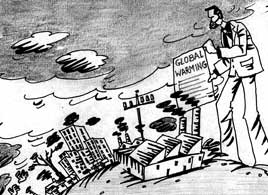Cat out of the bag
 Scientists from Imperial Collegeukhave come out with the first observed evidence of increase in greenhouse effect on Earth between 1970 and 1997. Previous studies in this area have depended on theoretical simulations because of lack of data. Howeverthe researchers at the Imperial College reached their conclusions after analysing data collected by two different earth-orbiting spacecrafts in 1970 and 1997. The research shows that there has been a significant change in the Earth's greenhouse effect over the last 30 yearsa finding which is consistent with concerns over so-called "radiative forcing' of the climate. Radiative forcingdefined as the change in the average net radiation at the top of the atmosphere because of a change in either solar or infrared radiationis a measure of the climate effect of greenhouse gases.
Scientists from Imperial Collegeukhave come out with the first observed evidence of increase in greenhouse effect on Earth between 1970 and 1997. Previous studies in this area have depended on theoretical simulations because of lack of data. Howeverthe researchers at the Imperial College reached their conclusions after analysing data collected by two different earth-orbiting spacecrafts in 1970 and 1997. The research shows that there has been a significant change in the Earth's greenhouse effect over the last 30 yearsa finding which is consistent with concerns over so-called "radiative forcing' of the climate. Radiative forcingdefined as the change in the average net radiation at the top of the atmosphere because of a change in either solar or infrared radiationis a measure of the climate effect of greenhouse gases.
Comparison between the two data sets has unequivocally established that increase in greenhouse gas emissions from the Earth have increased the greenhouse effect. John Harriesthe head of the research teamsays"The unique satellite spectrometer data collected 27 years apart shows for the first time that spectral differences exist and and that they can be attributed to changes in greenhouse gases emissions.'
The team examined the infrared spectrum of long-wave radiation data from a region over the Pacific Ocean. They discovered significant differences in the data collected in 1970 and in 1997 for the levels of atmospheric methanecarbon dioxideozone and two chlorofluorocarbons.
Although the two series of data were collected using different equipment flown on separate spacecrafts 27 years apartthe research team showed that the comparison of outgoing infrared long-wave radiation spectra was valid. The researchers worked to discount the differences that may have occurred due to the different data collection methods before going ahead with their analysis.
Helen Brindleya co-researchersays"We have shown that the magnitude of the changes observed can only be explained by long-term changes in the emissions of greenhouse gases such as carbon dioxidemethane and chlorofluorocarbons.' Harries says"We have only begun to make use of these spectral observations. Much more information is locked up in the data. This provides a strong motivation for the launch of similar instruments to monitor the state of our climate.'
Related Content
- First food: business of taste
- Order of the National Green Tribunal regarding an illegal cracker unit in Thanjavur district, Tamil Nadu, 29/05/2025
- Order of the National Green Tribunal regarding pollution of Godavari river, Telangana, 29/05/2025
- Order of the National Green Tribunal regarding dumping of waste in a canal in Chennai, Tamil Nadu, 29/05/2025
- Order of the National Green Tribunal regarding violation of environmental norms by a tyre pyrolysis plant, village Sakauti, Shamli, Uttar Pradesh, 28/05/2025
- Order of the National Green Tribunal regarding waste disposal in Ghazipur drain, Delhi, 28/05/2025
